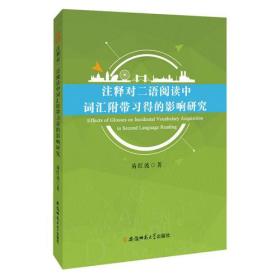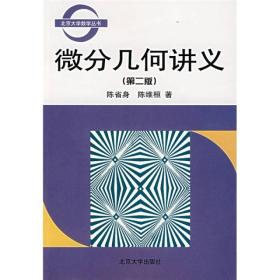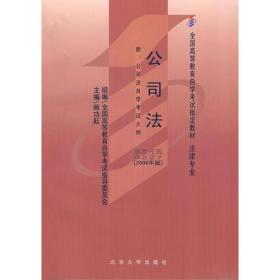
注释对二语悦读中词汇附带习得的影响研究
¥ 28.75 9.6折 ¥ 30 九五品
仅1件
河北廊坊
认证卖家担保交易快速发货售后保障
作者易红波
出版社安徽师范大学出版社
出版时间2017-08
版次1
装帧其他
货号A22
上书时间2024-12-12
- 在售商品 暂无
- 平均发货时间 13小时
- 好评率 暂无
- 最新上架
商品详情
- 品相描述:九五品
图书标准信息
- 作者 易红波
- 出版社 安徽师范大学出版社
- 出版时间 2017-08
- 版次 1
- ISBN 9787567629103
- 定价 30.00元
- 装帧 其他
- 开本 16开
- 纸张 胶版纸
- 页数 292页
- 字数 370千字
- 【内容简介】
- 本书共七章内容,为安徽省2017年度高校优秀青年人才支持计划重点项目“二语阅读中词汇附带习得影响因素研究”的部分研究成果。书中对同一篇英语阅读材料中的10个目标词(动词、名词和形容词)采取不同语言注释(汉语、英语、汉语 英语、无注释)、不同选项注释(单项和双项注释)及不同位置注释(夹注、页边注、脚注和尾注),考察不同注释方式对英语学习者英语阅读及阅读中词汇附带习得的影响。研究发现注释能显著性地促进学习者英语阅读及阅读中的词汇附带习得,尤其是单项汉语 英语的页边注释。就学习者的语言水平而言,高水平学习者在各注释方式中的英语阅读和词汇附带习得成绩均高于低水平学习者。同时研究结果显示:加工程度较深的信息不一定能进入长时记忆,该结果与“投入量假说”相悖。本研究结果对英语教材编撰及英语词汇教学有着重要的启示意义,同时也为相关理论的修正提供了直接证据。
- 【作者简介】
- 易红波,安徽机电职业技术学院英语教师,讲师,外国语言学及应用语言学专业硕士研究生。2010年至今工作于安徽机电职业技术学院。迄今发表论文10余篇,主持教育厅人文社会科学研究一般项目1项,院级人文社会科学研究一般项目1项、重点项目1项,入选2017年度安徽高校优秀青年人才支持计划重点项目;参与教育厅人文社会科学研究重点项目1项,省级质量工程教学研究一般项目1项、重大项目1项,院级质量工程教学研究重点项目1项。
- 【目录】
-
目录:Contents
Chapter One Introduction 1
1.1 Need for the Study 1
1.2 Significance of the Study 3
1.3 Organization of the Thesis 4
Chapter Two Literature Review 6
2.1 Incidental Vocabulary Acquisition 6
2.1.1 Definitions of Incidental Vocabulary Acquisition 6
2.1.2 Advantages and Disadvantages of Incidental Vocabulary Acquisition 8
2.1.3 Summary 10
2.2 Incidental Vocabulary Acquisition and L2 Reading 10
2.2.1 Incidental Vocabulary Acquisition through L2 Reading 11
2.2.2 Advantages and Disadvantages of Incidental Vocabulary Acquisition through L2
Reading 13
2.2.3 Summary 15
2.3 Factors Influencing Incidental Vocabulary Acquisition through L2 Reading 16
2.3.1 Learner Factors 16
2.3.2 Text Factors 18
2.3.3 Lexicon Factors 18
2.3.4 Context Factors 20
2.3.5 Summary 21
2.4 Ways to Enhance Incidental Vocabulary Acquisition 21
2.5 Glosses 23
2.5.1 Definitions of Glosses 23
2.5.2 Types of Glosses 24
2.5.3 Functions of glosses 25
2.5.4 Summary 26
2.6 Previous Studies on Effects of Glosses on Incidental Vocabulary Acquisition through
Reading 27
2.6.1 Effects of Glosses in Different Languages on Incidental Vocabulary Acquisition 27
2.6.2 Effects of Glosses with Different Numbers on Incidental Vocabulary Acquisition 31
2.6.3 Effects of Glosses in Different Positions on Incidental Vocabulary Acquisition 35
2.6.4 Limitations of the Previous Studies 38
2.6.5 Summary 41
2.7 Theoretical Framework 41
2.7.1 Theory of Depth Processing 41
2.7.2 Involvement Load Hypothesis 43
2.7.3 Noticing Hypothesis 45
2.7.4 Input Hypothesis 46
2.7.5 Output Hypothesis 47
2.7.6 Summary 48
2.8 Summary 48
Chapter Three Research Design 49
3.1 Reading Material 49
3.2 Time for the Delayed Vocabulary Test 50
3.3. Evaluation of Learners’ Language Proficiency 51
3.4 Assessment of Incident Vocabulary Acquisition 52
3.5 Summary 54
Chapter Four Empirical Study I 55
4.1 Methodology 55
4.1.1 Research Questions 55
4.1.2 Participants 55
4.1.3 Target Words 56
4.1.4 Date Collection 57
4.2 Data Analysis and Results 57
4.2.1 Relationship between Leaners’ Language Proficiency and Reading Comprehension 57
4.2.1.1 Reading Comprehension under Four Glossing Conditions 57
4.2.1.2 Effects of Learners’ Language Proficiency on Reading Comprehension 60
4.2.2 Relationship between Learners’ Language Proficiency and Incidental Vocabulary Acquisition 62
4.2.2.1 Results of the Immediate Vocabulary Test 62
4.2.2.2 Results of the Delayed Vocabulary Test 66
4.2.2.3 Differences between Two Vocabulary Tests 70
4.3 Discussion 74
4.4 Summary 79
Chapter Five Empirical Study II 80
5.1 Methodology 80
5.1.1 Research Questions 80
5.1.2 Participants 80
5.1.3 Target Words 81
5.1.4 Date Collection 82
5.2 Data Analysis and Results 82
5.2.1 Relationship between Learners’ Language Proficiency and Reading Comprehension 82
5.2.1.1 Reading Comprehension under Two Glossing Conditions 83
5.2.1.2 Effects of Learners’ Language Proficiency on Reading Comprehension 84
5.2.2 Relationship between Learners’ Language Proficiency and Incidental Vocabulary Acquisition 85
5.2.2.1 Results of the Immediate Vocabulary Test 85
5.2.2.2 Results of the Delayed Vocabulary Test 87
5.2.2.3 Differences between Two Vocabulary Tests 89
5.3 Discussion 92
5.4 Summary 96
Chapter Six Empirical Study III 97
6.1 Methodology 97
6.1.1 Research Questions 97
6.1.2 Participants 97
6.1.3 Target Words 98
6.1.4 Data Collection 99
6.2 Data Analysis and Results 99
6.2.1 Relationship between Learners’ Language Proficiency and Reading Comprehension 99
6.2.1.1 Reading Comprehension under Four Glossing Conditions 99
6.2.1.2 Effects of Learners’ Language Proficiency on Reading Comprehension 102
6.2.2 Relationship between Learners’ Language Proficiency and Incidental Vocabulary Acquisition 103
6.2.2.1 Results of the Immediate Vocabulary Test 103
6.2.2.2 Results of the Delayed Vocabulary Test 106
6.2.2.3 Differences between Two Vocabulary Tests 110
6.3 Discussion 113
6.4 Summary 118
Chapter Seven Conclusion 119
7.1 Major Findings of the Research 119
7.2 Implications of the Research 124
7.3 Limitations of the Research 127
7.4 Suggestions for the Future Research 127
References 129
Appendices 138
点击展开
点击收起
— 没有更多了 —












以下为对购买帮助不大的评价